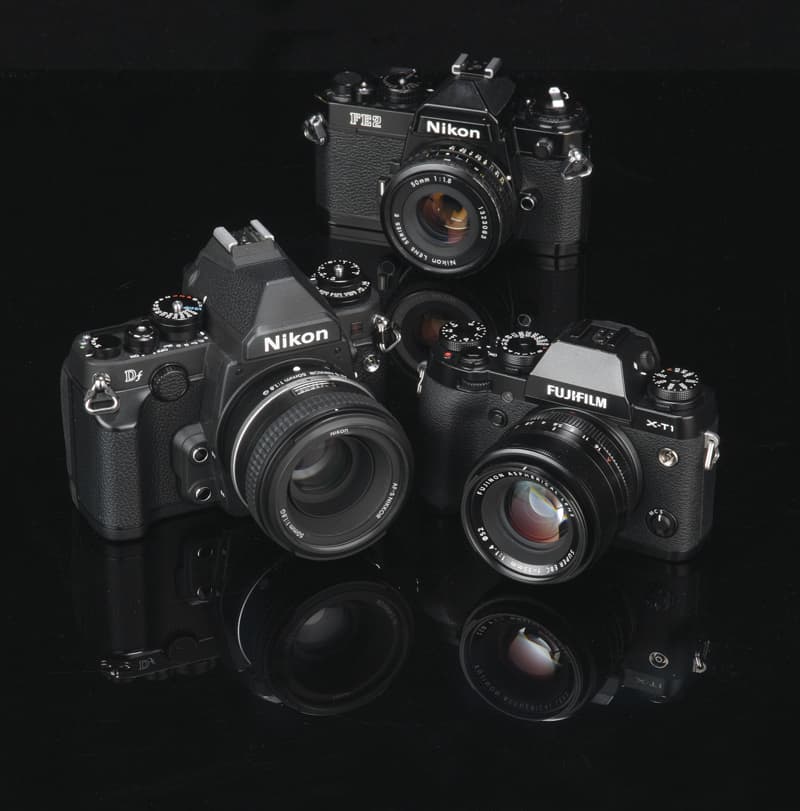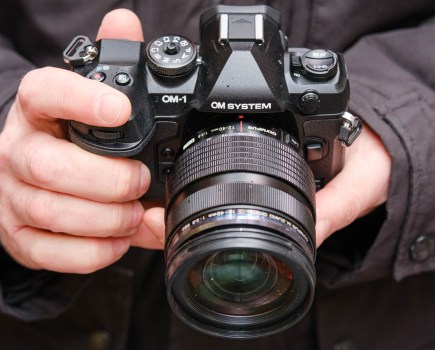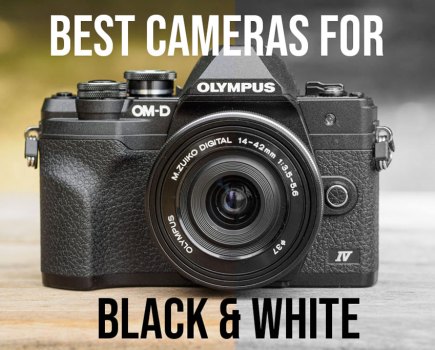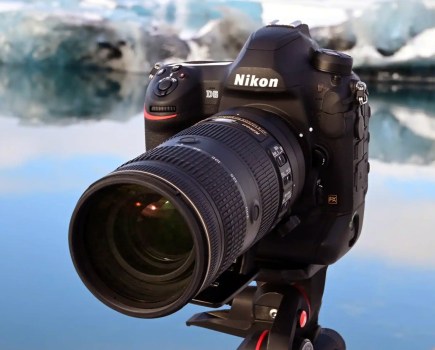Image: Compared to the Nikon FE2 (back), it is clear to see the influence of 1970s SLR cameras on the Fujifilm X-T1 (right) and Nikon DF (left)
This is not a straight X vs Y head-to-head contest between the Fujifilm X-T1 and the Nikon Df. Both of these cameras have already been tested (in AP 15 March and 18 January respectively) and each scored highly, producing excellent images. Both models also have their own quirks when it comes to how they handle.
What is more interesting is that Fujifilm and Nikon have created cameras to meet the demand for a digital model that handles like a film SLR. Both have a different answer to the same question, with each a pastiche of a 1970s film SLR. On the one side is a retro-looking DSLR with a full-frame sensor and a large optical viewfinder, and on the other is a smaller and lighter CSC with an APS-C-sized sensor and an EVF. Each offers an array of buttons and dials.
Also, I am not seeking to prod the hornets nest of the film vs digital debate. Trying to get the two sides of that argument to agree is like asking cats and dogs to be friends. Film and digital cameras have their own needs, and it isn’t simply a case of transposing the controls of a film model onto a digital version.
How features affect design
When I look back at past tests that my predecessors have carried out on film cameras, I do so with great envy. They picked up the camera, stocked up on a few films of their choice and went out to take pictures. The tests involved assessing the handling of the camera, the light metering options and accuracy. Although electronic film cameras had other features that needed testing, it was a simpler process than testing a DSLR. Film SLRs don’t have colour or luminance noise. Neither do they have different white balance and colour modes, or a dynamic range, or raw-file compression. In fact, during the first 90 years of Amateur Photographer, autofocus did not exist.
Cameras have become more complicated. Having worked in retail, I can say that the most frequent request from customers walking into a shop is for a camera that is simple to use. In fact, that is what most photographers would really like. We want to spend more time out exploring and taking great photographs, but we don’t want to waste time adjusting settings and modes. It is this need that drives the ‘I want a digital camera that behaves like film a film camera’ ethos.
All the functions that we now have available to us on a digital camera need to be controlled, be it through a button, a dial or an on-screen menu. This adds to the complexity of a camera’s operation, and it can make it intimidating to use. Three of my favourite film cameras that I have owned are the Canon AE-1, Pentax ME Super and Nikon F80. All were high-end enthusiast models in their time, but now they seem so simple to operate.

It’s not just the controls that have changed in the design of digital cameras. The two key components of any digital model – the sensor and the LCD screen – affect the physical design of the body. One way to see this is by comparing the location of the focal-plane markers on a camera. Compared to a vintage SLR, the focal-plane markings on the Nikon Df and Fujifilm X-T1 are now further from the rear of the camera. A digital camera’s sensor, sensor-shift mechanism, circuit board and LCD screen all fit behind the focal plane, so require extra space, compared to a film camera’s simple sprung backplate that holds a thin piece of film flat.
When Nikon launched the Df, many people hoped that the size of the camera would be more in keeping with that of the company’s FM or FE film range. Better still, many hoped that the new model would match the 53mm depth of the smallest Nikon F-mount camera, the FG. However, to produce something of this size with current technology is difficult. There is around 1mm difference between the focal plane and the rear of the Nikon Df and Fuji X-T1 digital cameras. What makes these two models so different in size compared to a film SLR is down to what is in front of the sensor.
In the case of the X-T1, there is no mirror mechanism. The back flange distance from the lens mount to the sensor is 17.7mm on the Fujifilm X mount. Compare this to the 46.5mm distance between the mount and focal plane on Nikon F-mount cameras. It is clear to see the difference that the SLR mechanism makes to the size of the camera. In fact, the flange-back distance of the Nikon F is almost the same as the entire 47mm thickness of the X-T1 body. Take the handgrip out of the equation and the X-T1 is around 37mm thick, and it includes an articulated screen.
There was some speculation that the Nikon Df would be a mirrorless F-mount camera, but, as we saw with the mirrorless Pentax K-01 K-mount CSC, the lack of a mirror makes little difference in size. The K-01 just felt like a DSLR without the optical viewfinder, leaving some to cruelly describe
it as being rather like a brick.
With no SLR mechanism in the X-T1, Fujifilm has been able to create a camera that is smaller than a classic SLR. It even looks like a SLR, but when you think about the design of the X-T1 there is no reason for it to have a central viewfinder position. The Fujifilm camera could have had an off-centre finder in the same way as its X-Pro1 stablemate. In fact, the viewfinder doesn’t even have to be in a prism-style box above the body of the camera – there is no physical need for it. The reason it is centrally located is to offer an experience akin to shooting on a SLR, with a design to match.
With all the modern conveniences of digital imaging, the Nikon Df is larger than the manual-focus film SLRs that it aims to mimic. It is around the same size as the nearest full-frame DSLR in Nikon’s line-up, the D610. However, unlike a regular Nikon DSLR, the Df has many more dials. On its top-plate are sensitivity, exposure compensation and shutter speed dials, while the standard control dials on the front and rear of the camera adjust the lens aperture.
The Fujifilm X-T1 has a similar array of dials, except only the sensitivity dial and the shutter speed dial have locks. The exposure compensation dial isn’t lockable, which makes it easy to shift when needed. A few photographers will bemoan the lack of a lock on this dial. On some cameras, these dials shift when they are knocked, resulting in a change in exposure setting. I have found no such issue with the dial of the X-T1. The exposure compensation dial has enough torque that it requires quite a deliberate turn to shift it out of its position.
On the Nikon Df, all the dials have locks, which can be a little frustrating when changing the exposure compensation. The position of the exposure compensation dial is also in an awkward place. Whereas Fujifilm placed this dial on the right-hand side of the X-T1’s top-plate, making it simple to adjust with your thumb while still holding the camera to your eye, on the Nikon Df the dial is on the left-hand side. This requires you to remove your hand from the lens, which can be awkward when using heavy glass. Not only this, but the lock button means that it is necessary to use both the thumb and forefinger to adjust the dial. The result is that the Df is slower and more awkward to make what should be quick adjustments.
As I mentioned in my original test of the Df, the front control dial also seems to be an exercise in design rather than ergonomics. The dial is positioned vertically rather than horizontally, which, due to its position on the front of the body, makes it slightly awkward to use. Most manufacturers, including Nikon, place this control dial horizontally in a more accessible position on the front of the camera.
A further annoyance with the Df is its power switch, which is in the perfect position to be switched with the forefinger while holding the camera. However, it has ridged sides for purchase, rather than being a simple knob, which makes it more difficult to switch on in one-handed operation compared to the X-T1. It is only a very simple ergonomic difference, but it is so simple that you wonder why Nikon didn’t use a slight variant of its standard power switch.
Each camera also has its own quirks when it comes to their respective menu systems. While Fujifilm’s menu has got a lot better in the past few years, it is still detailed and extensive and can take some time to find the feature or function that you need. Also, it is frustrating that the extended ISO settings are only available for JPEGs and not raw format.
The Df, on the other hand, has the option to review an image on the rear screen turned off by default. So, after you have taken an image with the Df, you have to hit the play button to view it. This goes against the way every other digital camera operates, and everyone I know who has used the Df has immediately gone in to the menu system and changed this setting. Part of the popularity of digital imaging is its immediacy – of being able to see an image you have just taken. As much as Nikon wants the Df to behave like a film SLR, having the instant preview turned off by default goes against what photographers want from a digital camera. Luckily, it can be changed in the custom menu.
The Df does have some nice touches, such as the tiny LCD on the top-plate that looks like a frame counter on a film SLR, and the cable-release screw thread on the shutter button. The Fuji X-T1 lacks both these features, but overall I prefer the way the X-T1 handles. The size and weight of the X-T1 make it a much better option for those who want a high-quality travel camera, and like the Nikon Df, its body is weather-sealed. The X-T1 also has an articulated screen, making it easy to shoot at awkward angles.

As the graph above shows, at low sensitivities the dynamic range of the two cameras is remarkably similar, although the Nikon Df has around a 0.7EV better dynamic range at its peak. However, as the ISO sensitivity increases, the smaller sensor of the Fujifilm X-T1 has an advantage, and in fact that there is little difference in the dynamic range between ISO 100 and ISO 1600. There are some very slight peaks in the graph of the X-T1, but these are within a margin of error and don’t interfere
with the overall trend.
The original raw images below were shot at ISO 200, and then both images have had their exposure increased by +5EV in Adobe Camera Raw 8.4. The detail that becomes visible is quite astounding and there is little to choose between each model. At a push, I would say that, at this sensitivity, the Df just edges the X-T1 in showing slightly more fine detail, but generally at low sensitivities both cameras are a match for each other.

Image: The image was deliberately underexposed and then brightened by +5EV. The enlargements show what detail can be recovered

These images show 72ppi (100% on a computer screen) sections of images of a resolution chart, captured using the XF 35mm f/1.4R lens set to f/5.6 for the Fujifilm X-T1 and the Sigma 105mm f/2.8 macro lens set to f/5.6 for the Nikon Df. We show the section of the resolution chart where the camera starts to fail to reproduce the lines separately. The higher the number visible in these images, the better the camera’s detail resolution is at the specified sensitivity setting.


Images: Despite the resolution charts showing that the X-T1 has the edge
in terms of resolution, there is actually very little difference in
real-world images

Image: The standard 2×2 Bayer pattern (left) looks far more random than the 6×6 X-Trans array (right)
The sensors from each camera have similar resolutions: 16.2 million pixels in the Nikon Df, and 16.3 million pixels in the Fujifilm X-T1. However, the two sensors are very different in their design.
The Nikon Df uses the same sensor as the company’s professional-level D4. This 16.2-million-pixel, full-frame CMOS sensor is designed by Nikon and manufactured by a third-party. Chipworks (www.chipworks.com) revealed the details of the sensor when it took apart a Nikon D4.
In contrast, the Fujifilm X-T1 has a smaller 16.3-million-pixel, APS-C-sized sensor, which is the same as that used in Fuji’s X-E2 and is believed to be the same Sony 16.3-million-pixel unit that is used in a number of other cameras. Fujifilm then supplies the X-Trans filter array, which is fabricated onto the sensor.
For those who are unfamiliar with the Fujifilm X-Trans filter array, it uses a 6×6-pattern array. In comparison, most other digital cameras, including the Nikon Df, use a standard 2×2 Bayer pattern filter. The result is that the X-Trans array appears more random in appearance, as can be seen in the diagrams above. The more random pattern helps to reduce false colour and moiré patterning. As a result of this, the X-Trans sensor doesn’t need an anti-aliasing filter, which makes the X-T1 capable of resolving more detail compared to the Nikon Df. Where the Df hits around 26 on our resolution chart, the X-T1 is able to reach almost 30. However, in real-life examples there was very little difference in edited raw images, although the X-T1 raw files require a little less sharpening.
One of the key differences between the Nikon Df and the Fujifilm X-T1 is their respective optical and electronic viewfinders. Both viewfinders offer 100% coverage, with the Df having a 0.7x magnification and the X-T1 0.77x magnification. In use, both viewfinders seem similar in size. At 2.36 million dots, the OLED electronic viewfinder of the X-T1 matches the resolution of other high-end EVFs. However, the larger magnification makes a real difference, with the view appearing as large as it does in the optical viewfinder of the Df.
There are obviously times when using an optical viewfinder is preferred. For example, when photographing fast-moving subjects, the refresh rate and fractional lag of an EVF can make a difference compared to using an optical unit. That said, the 56fps refresh rate of the EVF and 0.005sec shutter lag are impressive in the X-T1, and although the image presented still doesn’t quite look like an optical image, it does have its advantages.
The most obvious advantage of an EVF is being able to preview how your image will look even before taking it. The EVF of the X-T1 has a better dynamic range than the rear screen, so colour and contrast are improved. This means you can adjust exposure and colour settings, and see something close to what the final image will look like.
The size of the EVF in the X-T1 also offers some interesting new features. The best of these is the dual view mode. This shows the scene on the left-hand side of the EVF, and on the right is a 100% enlargement to make it easy to manually focus. The enlarged section can also be used with focus peaking or Fuji’s unique split-image focusing.
To test how easy it is to manually focus with each camera, I took a series of 10 images of the same subject. After manually focusing and taking an image, I set the lens to its minimum focus distance and focused on my subject again. Of the two cameras, I found that the Df was quicker for me to manually focus. It was easy to get the lens roughly in focus, and then tweak the focus using the AF indicator at the bottom of the viewfinder as a guide.
Although the X-T1 was slightly slower when I was manually focusing, I found that the split-image focusing, focus peaking and the 100% magnification meant that I was able to focus more accurately. Of the 10 images I took, nine were pin-sharp and I had just missed my point of focus in one image. Manually focusing on the Df, I found that seven of the images were pin-sharp, and I had just missed in three.
At some point in a future issue, I plan to conduct a larger test and comparison of viewfinder technology to what it means to photographers. Yet, from my simple test here, I would conclude that manual focusing with the EVF of the X-T1 has an advantage over using the optical unit on the Df.
As to which of the two viewfinders is more akin to using a film SLR, you would naturally say that it is the optical unit on the Nikon Df. However, the split-image focusing of the Fujifilm X-T1 is like using split-prism focusing on a SLR, so the decision isn’t as clear cut as you would expect. How photographers use their cameras is the biggest factor in deciding whether they should opt for an electronic or optical viewfinder.
Both the Fujifilm X-T1 and Nikon Df are great cameras and I’m sure each will prove to be very popular with enthusiast photographers. However, if you are looking for a film SLR experience, then I would choose the X-T1.
The size and shape of the Fuji X-T1 are more similar to a film SLR than the Nikon Df is, and anyone who likes to manually focus will love the split-image focusing. Also, the fact that the X-T1’s colour modes are based on classic Fuji films, such as Provia and Velvia, will also resonate with photographers.
As for the larger question about producing a digital camera that behaves like a film SLR, I think the problem may resolve itself when screen technology improves to an extent that the panels can be thinner. Shaving a couple of millimetres off the camera body can make a big difference. Alternatively, by removing the rear LCD screen completely, a digital camera DSLR could be a lot smaller in height and in depth. Obviously, this would make it much harder to change settings or review images, but perhaps if there were a hybrid optical/digital viewfinder, like that found on the Fujifilm X-Pro1, then this could become a possibility.
 Specification – Fujifilm X-T1
Specification – Fujifilm X-T1
RRP: £1,049.99 (body only) or £1,399.99 with 18-55mm f/2.8-4 lens
Sensor: 16.3-million-effective-pixel, APS-C-sized X-Trans CMOS II
Output size: 4896 x 3264 pixels
Lens mount: X mount
File format: Raw (RAF) JPEG, raw + JPEG
Metering system: 256-zone TTL metering system
Colour space: Adobe RGB, sRGB
Shutter speeds: 30-1/4000sec, plus bulb
Viewfinder: 0.5in, 2.36-million-dot OLED colour EVF ISO: ISO 200-6400, extendable to ISO 100-51,200
White balance: Auto, 7 presets, Kelvin, plus custom setting
AF points: 49 areas, selectable manually or automatically
Weight: 440g (including battery and memory card)
Dimensions: 129 x 89.8 x 46.7mm

Specification – Nikon Df
RRP: £2,749.99 (with 50mm f/1.8G lens)
Sensor: FX-format (full-frame) CMOS sensor with 16.2 million effective pixels
Output size: 4928 x 3280 pixels
Lens mount: Nikon F
File format: NEF (raw), JPEG, raw + JPEG simultaneously
Metering system: 2016-pixel RGB 3D matrix metering
Colour space: Adobe RGB, sRGB
Shutter speeds: 30-1/4000sec in 1⁄3 steps, plus bulb
Viewfinder: Pentaprism single-lens reflex viewfinder
ISO: ISO 50-204,800 (extended)
White balance: 2 auto, 6 presets (with fine-tuning), plus 3 custom and Kelvin adjustment settings
AF points: 39 points, selectable manually or automatically
Weight: 710g (without battery or card/s)
Dimensions: 143.5 x 110 x 66.5mm








